Kanhangad
also known as Hosdurg is 35 kms south of Kasargod on the seashore. Hosdurg is
an important early settlement of gsbs, who migrated here in large numbers in the 16th
century. At present, there are about 300 gsb families in Kanhangad. The Laxmi Venkatesh
temple was established in 1864 AD. The temple is situated near the Hosdurg fort.
Deities
The main deity is Laxmi Venkatesh. There are also prathistas of
Garuda, Mahamaya (Shanta Durga), Ganapathy, Mahalaxmi, and Hanuman.
History & temple
details
Before the establishment of the temple, the GSBs
in Hosdurg had to go to Venkatramana temple at Kasargod for worship. In those days due to
lack of transportation facilities, the devotees had to reach the temple which is about 35
kms away by foot. |
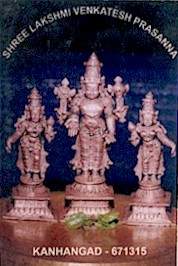
|
The samaj members felt the need for a temple
locally. In the middle of the 19th century, a group of men including Narayana Kamath,
Subraya Kamath, Sheshagiri Kamath and Ramachandra Naik, embarked upon the task of building
a temple for the community at Hosdurg. These four families together are known as Chowguli
families.
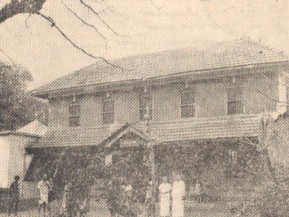 The site for construction
of the temple was donated by Subraya Kamath and his elder brother Manjayya Kamath. The
samaj members participated by way of donations and sramadan to construct
the temple. On Vaishakh Shuddha Tritheeya day of Rathakshi Samvatsara (1864 AD), the idol
of Lord Laxmi Venkatesh was duly installed in the temple by Srimat Bhuvanendra Tirtha
Swamiji of Kashi Mutt. The idol is from Innoli in
Nandavar village near Panemangalore, where the idol was entrusted to the custody of
the Swamiji by the samaj members in that village since the temple was very poor and could
not afford to provide expenses for daily Nivedya and Trikala Pooja regularly. While
installing the deity in Hosdurg, the Swamiji had made a special entreaty to the Lord to be
pleased with whatever little offering was made by poor and devot samaj members. The site for construction
of the temple was donated by Subraya Kamath and his elder brother Manjayya Kamath. The
samaj members participated by way of donations and sramadan to construct
the temple. On Vaishakh Shuddha Tritheeya day of Rathakshi Samvatsara (1864 AD), the idol
of Lord Laxmi Venkatesh was duly installed in the temple by Srimat Bhuvanendra Tirtha
Swamiji of Kashi Mutt. The idol is from Innoli in
Nandavar village near Panemangalore, where the idol was entrusted to the custody of
the Swamiji by the samaj members in that village since the temple was very poor and could
not afford to provide expenses for daily Nivedya and Trikala Pooja regularly. While
installing the deity in Hosdurg, the Swamiji had made a special entreaty to the Lord to be
pleased with whatever little offering was made by poor and devot samaj members.
Renovation and Punaprathista
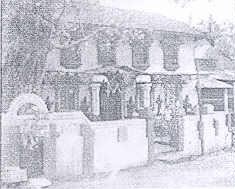 Although
the temple had a humble start, it has taken long strides during the last one and half
century in all spheres like infra-structure, festivals and social activities. The
temple srikovil was replaced by a new one. The quadrangle Pauli was renovated. In
1920, the punaprathista and Brahma Kalasabhisheka was done by Srimat Sukritheendra Tirtha
swamiji. In 1960, the second punaprathista was done by Srimat Sudheendra Tirtha swamiji of
Kashi mutt. The Jaya-Vijaya statues in front of the Garbhagraha were installed by the
Swamiji on this occasion. The parivara devas were installed by Srimat Sudheendra Tirtha
Swamiji in the presence of the Pondiffs of Kavale Mutt and Gokarn Mutt. A Sahasra
Kumbhabhisheka was conducted by Srimat Sudheendra Tirtha Swamiji in 1989. Although
the temple had a humble start, it has taken long strides during the last one and half
century in all spheres like infra-structure, festivals and social activities. The
temple srikovil was replaced by a new one. The quadrangle Pauli was renovated. In
1920, the punaprathista and Brahma Kalasabhisheka was done by Srimat Sukritheendra Tirtha
swamiji. In 1960, the second punaprathista was done by Srimat Sudheendra Tirtha swamiji of
Kashi mutt. The Jaya-Vijaya statues in front of the Garbhagraha were installed by the
Swamiji on this occasion. The parivara devas were installed by Srimat Sudheendra Tirtha
Swamiji in the presence of the Pondiffs of Kavale Mutt and Gokarn Mutt. A Sahasra
Kumbhabhisheka was conducted by Srimat Sudheendra Tirtha Swamiji in 1989.
The shrine of Mahamaya, where the Kalasha
Prathista was existing, was rebuilt by Keshav Srinivas Shanbhag and brothers and an idol
of the Goddess was installed. A Nagalaya was built by Damodar Sheshagiri Kamath. A
beautiful shrine for Sharada Devi was constructed near the temple tank Sukritheendra
Pushkarani. A shrine of Vitobha Rukmini where Sankeerthana Saptaha is being conducted
annually, was constructed in memory of Patel Narasimha Kamath.
A Kalyan Mantap was constructed in the holy name
of Sudhindra Kalyana Mantap at a cost of Rs. 12 lakhs. One more building in the holy
name of Bhuvanendra Kala Mandir costing about Rs.6.5 lakhs was constructed in 1989.
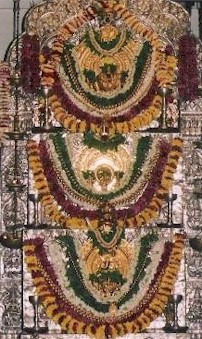
Main Prathista of Laxmi Venkatesh along with Utsav idol
|
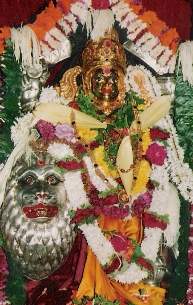
Mahamaya Shanta Durga
|
Festivals & Customs
The important annual festivals (Pancha parvas) in
the temple include Navarathri, Karthika Deepotsava, Rama Navami, Anantha Chathurdasi, and
the Moola Prathista day on Akshaya Tritiya. Each day of the Navarathri festival is
sponsored by certain families.
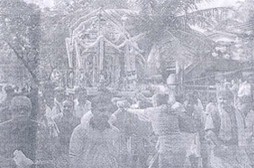 The Karthika Deepotsava has now-a-days become popular among the
general public. The Utsav idol of Venkatesh is taken out in the morning in decorated
silver palanquin to Melankot, considered to be the Vana or forest, where the pallivetta
(divine hunt) takes place. After the mid-day pooja, Vana Bhojan (meals) is provided to the
devotees. After the pallivetta and evening pooja, Lord returns to the temple with Arati
and fire works along the route. The Lord is placed in a chariot like tent (called Gurunja)
near the temple and witness the grand scale fire works. The Lord then re-enter the temple.
This festival is conducted by the Kotachery Shenoy family. The Karthika Deepotsava has now-a-days become popular among the
general public. The Utsav idol of Venkatesh is taken out in the morning in decorated
silver palanquin to Melankot, considered to be the Vana or forest, where the pallivetta
(divine hunt) takes place. After the mid-day pooja, Vana Bhojan (meals) is provided to the
devotees. After the pallivetta and evening pooja, Lord returns to the temple with Arati
and fire works along the route. The Lord is placed in a chariot like tent (called Gurunja)
near the temple and witness the grand scale fire works. The Lord then re-enter the temple.
This festival is conducted by the Kotachery Shenoy family.
A special attraction of this temple was the Oracle
or Devadarsan which has now ceased due to death of the incumbent Darshana Pathri.
Administration of the temple is vested in the
governing body and the Trustee board elected by the community members once in two years.
With a view to help the poor and aged, the temple authorities has started the Sudheendra
foundation which runs an old age home.
About
Kanhangad click for Kasargod district map
Kanhangad or Hosdurg is 35 kms south of Kasargod
and in the Hosdurg taluk having the remnant of a large fort built by Somasekhara Nayak of
Ikkeri. HOSDURG which originally belonged to Kannur district but has now become part
of Kasaragod district since its inception in 1984. The name Hosdurg is derived from
the kannada word Hosa (means new) and Durga (means Fort) and was once an integral part of
South Canara (Karnataka). In Kerala, tobacco is cultivated only in the Hosdurg Taluk.

There is a Bhadrakali
temple at Madiyamkulam about 3 km from Kanhangad, famed for its Bhutha
Dance performed in connection with the annual festival in May/June. There is a chain
of forts built by the Ikkery royal dynasty in the Kasargod district - Bekal fort, Hosdurg
fort and Chandragiri fort being the most important ones. The Hosdurg fort houses
several public offices and the Karpooreswara Temple.
 The 350 year old Bekal Fort is situated 10 Kms north of Kanhangad and is one of the
largest and best preserved forts in Kerala. This fort is under the Archeological dept of
Government of India. This imposing circular structure of laterite rises 130 ft. above sea
level and stands on a 35 acre head land that runs into the Arabian sea. Sivappa Naik of
the Ikkeri dynasty is said to have built the fort between 1645-1660. But some historians
are of the opinion that the fort was built by the then north Kerala rulers, the Kolathiri
Rajas. The 350 year old Bekal Fort is situated 10 Kms north of Kanhangad and is one of the
largest and best preserved forts in Kerala. This fort is under the Archeological dept of
Government of India. This imposing circular structure of laterite rises 130 ft. above sea
level and stands on a 35 acre head land that runs into the Arabian sea. Sivappa Naik of
the Ikkeri dynasty is said to have built the fort between 1645-1660. But some historians
are of the opinion that the fort was built by the then north Kerala rulers, the Kolathiri
Rajas.
There are two renowned ashrams in
Kanhangad.
Anandashram, situated about 4 kms. east of the Kanhangad Town, was
founded in 1939 by Swami Ramadas, a great Vaishnava saint of modern times. The main ashram
and other buildings have a beautiful setting in the midst of mango and coconut
groves.There is a hill to the east of the Ashram, to which the dovotees retire for quiet
meditation.
The Nityanandasram,
which is situated on the hillock about half a km. south of the Hosdurg taluk office, was
founded by Swami Nityananda. Here Swami Nityananda constructed 45 caves
in a mountain slope. There is a temple built in 1963, after the style and design of the
famous Somanatha Temple in Gujarat. A full size statue of Swami Nityananda in sitting
posture made of panchaloha is one of the attractions of the Ashram.
|
